Admission Rejection Letter
Dear [Applicant's Name],
Re: Admission Decision
I regret to inform you that after careful consideration of your application, the admissions committee has made the difficult decision to deny your admission to [Name of Institution] for the upcoming academic year.
We understand that receiving this news may be disappointing, and we want to assure you that the decision was made after a thorough review of your application and consideration of our institutional priorities and constraints. While your academic achievements and personal qualities are commendable, we received an overwhelming number of qualified applicants this year, making the selection process highly competitive.
Please know that the admissions committee's decision does not diminish your accomplishments or potential for success. We recognize your commitment and dedication to your studies, as well as your aspirations for a rewarding academic journey. However, due to the limited number of available spots, we are unable to offer you a place in the incoming class.
We encourage you to explore alternative educational opportunities that align with your interests and goals. Many reputable institutions offer programs and resources that can provide you with a high-quality education and a supportive learning environment.
Additionally, we recommend that you consider reapplying to [Name of Institution] in the future. While we cannot guarantee admission, we welcome the opportunity to review your application again and reassess your candidacy.
We appreciate the time and effort you invested in applying to [Name of Institution]. Your application showcased your unique talents and potential contributions to our community. We wish you all the best as you pursue your educational and career goals.
If you have any questions or would like further information regarding the admissions process, please feel free to contact our admissions office. We are here to assist you.
Once again, thank you for considering [Name of Institution]. We extend our best wishes to you for a successful academic journey.
Sincerely,
[Your Name]
[Your Title]
[Name of Institution]
[Contact Information]
Formal Admission Rejection Letter
Subject: Admission Decision - [Program Name]
Dear [Applicant Name],
We appreciate your interest in [Institution Name] and the effort you put into your application for [Program Name]. After careful consideration, we regret to inform you that we are unable to offer you admission at this time.
This decision was made after a thorough review of all applications, and it reflects the highly competitive nature of our admissions process. We encourage you to consider applying again in the future or exploring other programs that may suit your interests.
Thank you for considering [Institution Name], and we wish you success in your academic endeavors.
Sincerely,
[Admission Office / Authorized Signatory]
Heartfelt Rejection Letter
Subject: Admission Outcome for [Program Name]
Dear [Applicant Name],
It is with sincere regret that we inform you of our decision not to offer you a place in [Program Name] at [Institution Name]. The selection process was highly competitive, and this decision does not reflect on your abilities or potential.
We acknowledge your efforts and achievements and encourage you to pursue other opportunities that align with your goals. Thank you for your interest in our institution.
Warm regards,
[Admission Office / Authorized Signatory]
Preliminary/Provisional Rejection Notification Email
Subject: Provisional Admission Status - [Program Name]
Dear [Applicant Name],
We regret to inform you that your application for [Program Name] at [Institution Name] is currently not successful. This is a provisional notification pending final confirmation of remaining slots.
We encourage you to remain engaged with our institution and consider alternative programs or future application cycles.
Best regards,
[Admission Office / Authorized Signatory]
Informal Admission Rejection Message
Subject: Update on Your Application
Hi [Applicant Name],
Thank you for applying to [Program Name] at [Institution Name]. We’re sorry to let you know that we won’t be able to offer you a place this year.
We appreciate your interest and encourage you to apply again in future semesters.
Cheers,
[Admission Office / Authorized Signatory]
Professional Admission Rejection Letter With Encouragement
Subject: Admission Decision Notification
Dear [Applicant Name],
Thank you for your application to [Program Name]. After careful consideration, we regret to inform you that your application was not successful. The competition this year was intense, and our selection process considered multiple factors.
We encourage you to consider reapplying in subsequent admission cycles or exploring alternative programs that may align with your career goals.
Thank you again for your interest in [Institution Name].
Sincerely,
[Admission Office / Authorized Signatory]
Sad Tone Rejection Letter
Subject: Admission Outcome
Dear [Applicant Name],
We regret to inform you that we are unable to offer you admission to [Program Name] at [Institution Name]. This was a difficult decision due to the high caliber of applicants this year.
While this news may be disappointing, we hope you will continue pursuing your academic goals and consider other programs that may suit your interests.
Kind regards,
[Admission Office / Authorized Signatory]
Quick and Simple Rejection Email
Subject: Application Result
Dear [Applicant Name],
Thank you for applying to [Program Name]. We regret to inform you that we are unable to offer you a place.
Best wishes for your future endeavors.
[Admission Office / Authorized Signatory]
What / Why You Need an Admission Rejection Letter
An Admission Rejection Letter is an official communication from an educational institution notifying an applicant that their application has not been successful.
Purpose:
- Provide formal closure to the application process.
- Maintain professionalism and courtesy with applicants.
- Document the decision for administrative records.
- Encourage applicants to consider alternative opportunities or future applications.
Who Should Send an Admission Rejection Letter
- Admissions office or committee of the institution.
- Authorized administrative officers.
- Department heads or program coordinators, if applicable.
- Email may be sent by digital communications staff for online applications.
Whom Should Receive the Admission Rejection Letter
- Individual applicants whose admission requests were not successful.
- Parents or guardians, if applicants are minors, may also receive a copy.
- Agents or representatives who submitted applications on behalf of the student (if applicable).
When Should an Admission Rejection Letter Be Sent
- After the review and evaluation of applications.
- Once final admission decisions have been confirmed.
- Typically within the timeline published in the institution's admissions calendar.
- Promptly to allow applicants to consider other options.
How to Write and Send an Admission Rejection Letter
- Begin with a clear subject line referencing the program applied to.
- Greet the applicant respectfully by name.
- Clearly state the decision without ambiguity.
- Include a brief explanation of the competitive nature or reason for rejection if appropriate.
- Encourage future applications or alternative options.
- Use polite and professional language.
- Send via email or postal mail depending on how the application was submitted.
Formatting Guidelines for an Admission Rejection Letter
- Length: 2–4 paragraphs.
- Tone: Professional, courteous, and empathetic; adjust formality based on context.
- Style: Clear and concise, avoid unnecessary details.
- Mode: Email for online applications, printed letter for traditional applications.
- Wording: Use positive and encouraging language where possible.
- Etiquette: Always thank the applicant for their interest.
Requirements and Prerequisites Before Sending
- Ensure final admission decisions are confirmed and authorized.
- Review application materials to ensure fairness.
- Prepare template or personalized content for applicants.
- Verify spelling of applicant names and program details.
- Ensure compliance with institutional policies and deadlines.
FAQ About Admission Rejection Letters
-
Q: Can applicants appeal the decision?
A: Policies vary by institution; include instructions if appeals are allowed. -
Q: Should reasons for rejection be detailed?
A: Generally, a brief explanation is sufficient; avoid extensive critique. -
Q: Is it acceptable to encourage future applications?
A: Yes, it maintains goodwill and positive relationships. -
Q: Can this letter be sent via email?
A: Yes, digital communication is common, especially for online applications.
After Sending / Follow-up
- Confirm delivery of the email or receipt of the letter if mailed.
- Ensure administrative records are updated to reflect the decision.
- Handle any follow-up inquiries or appeals professionally.
- Provide additional guidance if the applicant requests alternative options or programs.
Tricks and Tips for Effective Admission Rejection Letters
- Personalize the greeting to make the letter more respectful.
- Keep the tone empathetic yet professional.
- Avoid using language that may seem dismissive or harsh.
- Maintain clarity to prevent misunderstandings.
- Send promptly to allow applicants to plan next steps.
Common Mistakes to Avoid
- Using vague or ambiguous language.
- Being overly critical or negative.
- Delaying the communication unnecessarily.
- Failing to verify applicant details before sending.
- Omitting encouragement or guidance for future opportunities.
Elements and Structure of an Admission Rejection Letter
- Subject Line: Clear reference to program and application.
- Greeting: Address applicant by full name.
- Introduction: Acknowledge the application and effort.
- Decision Statement: Clearly state rejection.
- Explanation: Optional brief mention of competitive selection or reason.
- Encouragement/Advice: Suggest future applications or alternative options.
- Closing: Polite thanks and well wishes.
- Signature: Authorized signatory or admissions office representative.
Pros and Cons of Sending Admission Rejection Letters
Pros:
- Provides clarity and closure to applicants.
- Maintains professionalism and institutional reputation.
- Encourages positive relationships with future applicants.
Cons:
- May disappoint applicants and cause negative feedback.
- Requires careful wording to avoid misinterpretation.
- Needs timely preparation and verification to avoid errors.
Compare and Contrast with Other Communication Types
- Rejection Letter vs. Acceptance Letter: Acceptance provides an offer; rejection communicates non-selection.
- Rejection Letter vs. Waitlist Notification: Rejection is final; waitlist implies potential future acceptance.
- Rejection Letter vs. Feedback Letter: Rejection focuses on decision; feedback provides detailed assessment of application quality.
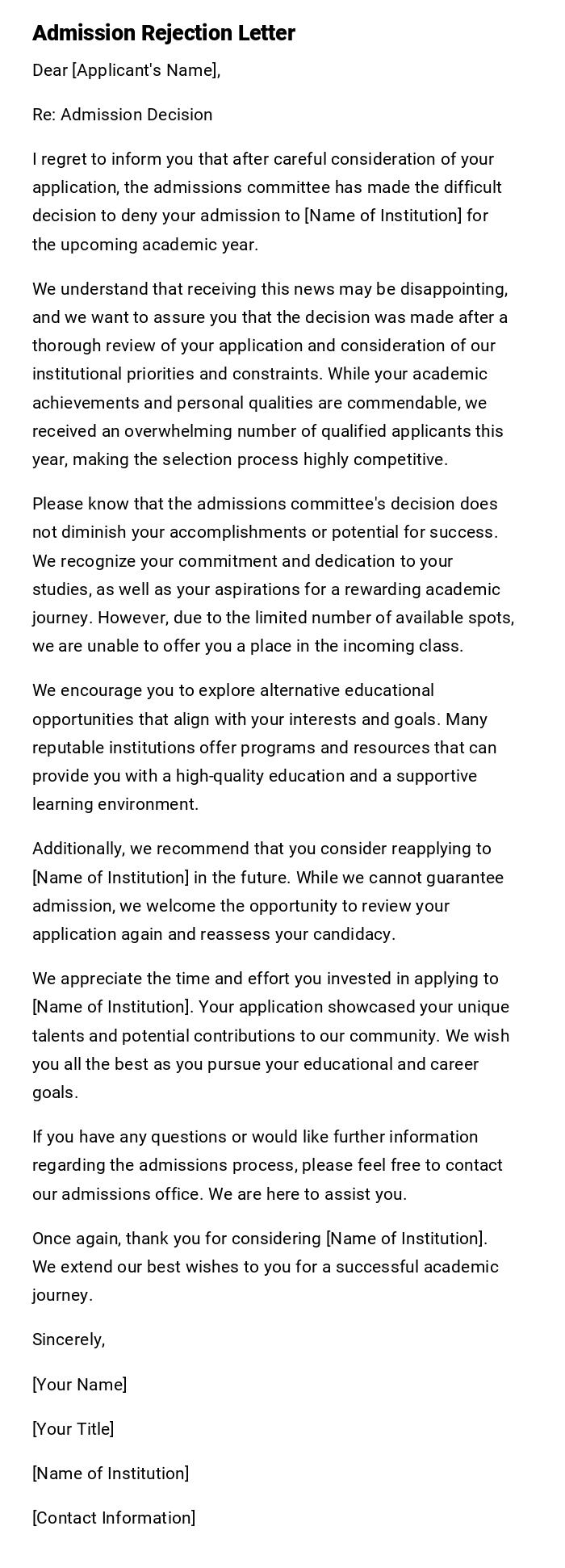
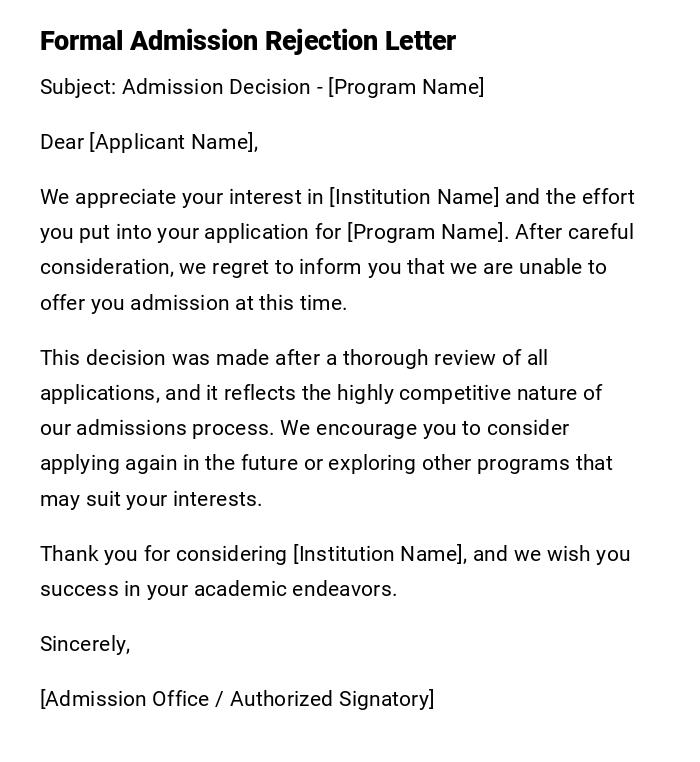
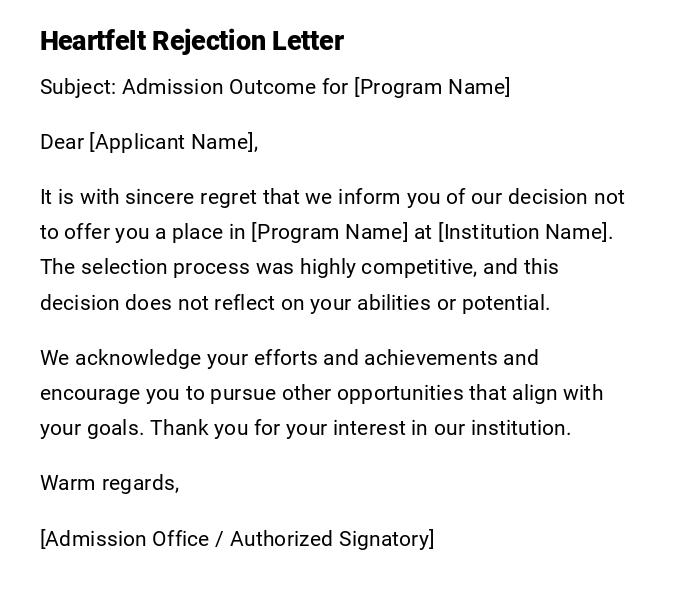
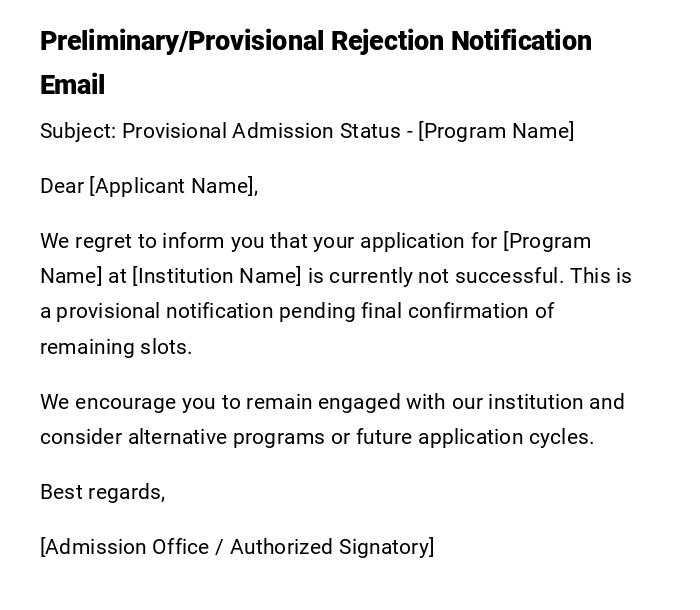
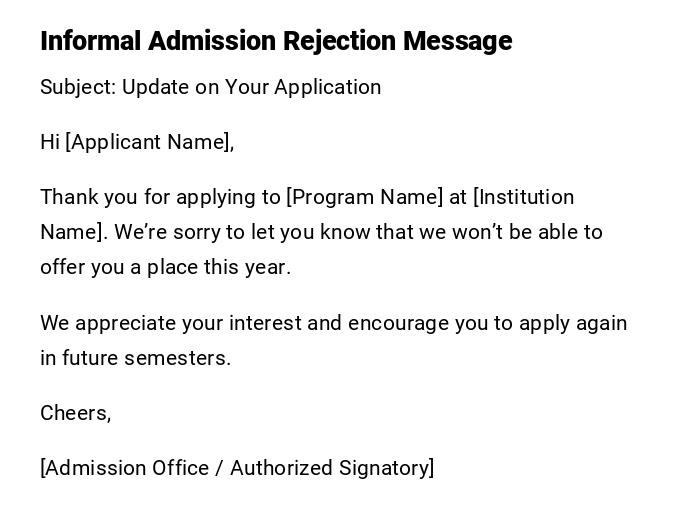
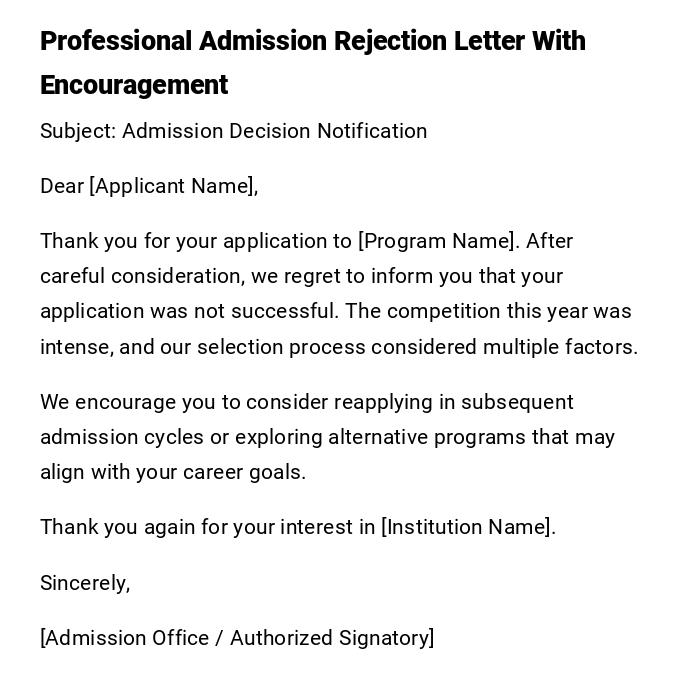
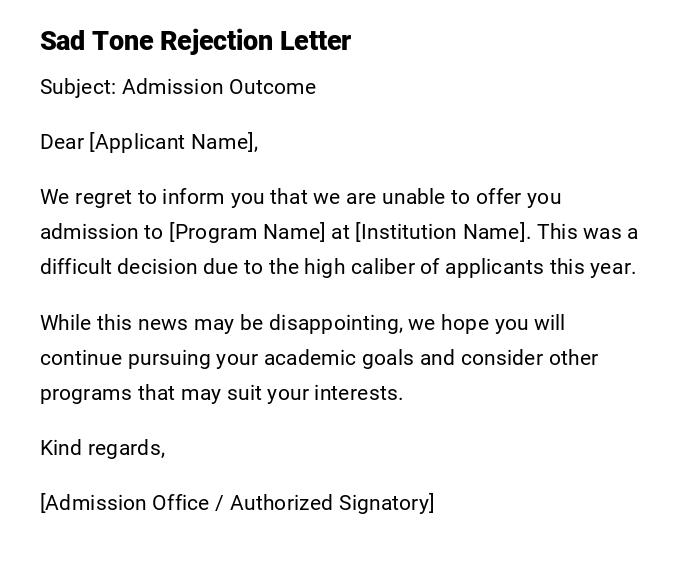
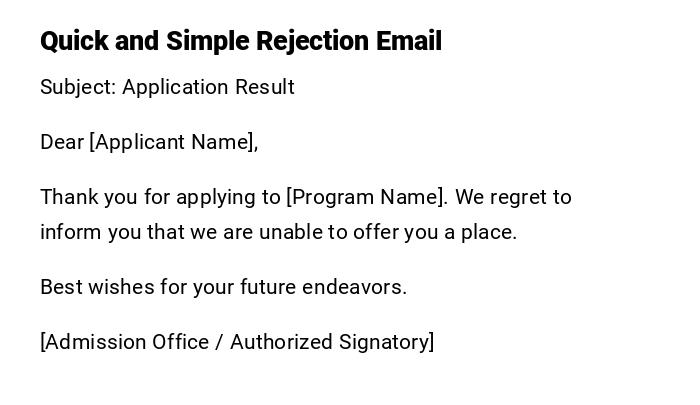

 Download Word Doc
Download Word Doc
 Download PDF
Download PDF